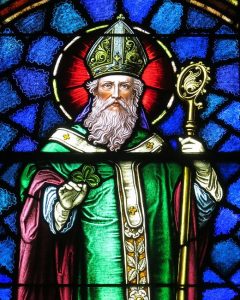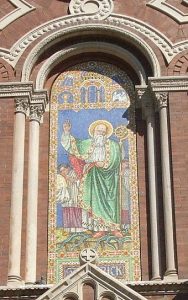 On this day in 461 A.D., Saint Patrick, Christian missionary, bishop and apostle of Ireland, dies at Saul, Downpatrick, Ireland.
On this day in 461 A.D., Saint Patrick, Christian missionary, bishop and apostle of Ireland, dies at Saul, Downpatrick, Ireland.
The Voice of the Irish
According to the Confessio, in Britain Patrick had another dream, in which an individual named Victoricus gave him a letter, entitled “The
Voice of the Irish.” As he read it, Patrick seemed to hear the voices of Irishmen pleading him to return to their country and walk among them once more. After studying for the priesthood, Patrick was ordained a bishop. He arrived in Ireland in 433 and began preaching the Gospel, converting many thousands of Irish and building churches around the country. After 40 years of living in poverty, teaching, traveling and working tirelessly, Patrick died on March 17, 461 in Saul, where he had built his first church.
The Legends of St. Patrick
Since that time, countless legends have grown up around Patrick. Made the patron saint of Ireland, he is said to have baptized hundreds of people on a single day, and to have used a three-leaf
clover–the famous shamrock–to describe the Holy Trinity. In art, he is often portrayed trampling on snakes, in accordance with the belief that he drove those reptiles out of Ireland.
For thousands of years, the Irish have observed the day of Saint Patrick’s death as a religious holiday. Therefore they attend church in the morning and celebrate with food and drink in the afternoon.
The first St. Patrick’s Day parade, though, took place not in Ireland, but the United States. This is when, in 1762 Irish soldiers serving in the English military marched through New York City. As the years went on, the parades became a show of unity and strength for persecuted Irish-American immigrants. Furthermore the parades became a popular celebration of Irish-American heritage. The party went global in 1995, That is when the Irish government began a large-scale campaign to market St. Patrick’s Day. The purpose was to drive tourism and showcase Ireland’s many charms to the rest of the world. Today, March 17 is a day of international celebration. Millions of people around the globe put on their best green clothing to drink beer, watch parades and toast the luck of the Irish.



Beautiful music, Thanks, Brad!
My beautiful horse that I had for 16 years was named Danny Boy.
The article was very interesting, too.
Very interesting read about St. Patrick. Thank you for sharing it. The Celtic women singing their version of Danny Boy was soooooo beautiful! Did you catch the Celtic music on PBS Sat night? Scott & I listened to it. He has quite a few CDs of the music.
I am continually amazed & inspired when reading the stories of those who have gone before us and helped to prepare the way for others by their great sacrifice. It truly is beyond my understanding when it comes to God’s ways & wisdom as he weaves together lives, events, people and their times in order to fulfill his purpose. What a glorious God we serve! Certainly the gifted Celtic women have been blessed with the voices of angels!
Thank you, Brad, for a wonderful St. Patrick’s Day blessing!